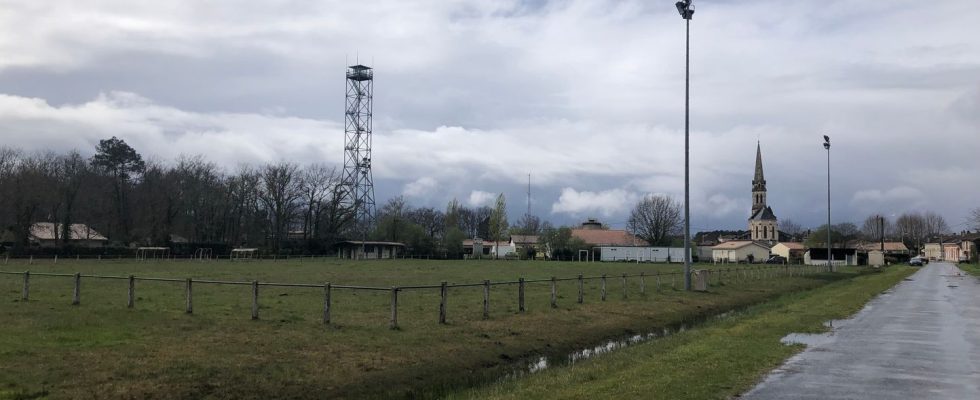“My brother played football and my father was a referee, there were also quite a few parties organized there,” recalls Laëtitia, 38, on her doorstep which overlooks the stadium. Salaunes, a small town of 1,200 inhabitants forty-five minutes from Bordeaux, where she grew up. Abandoned for almost ten years, because the village no longer has a football club, the equipment is in a sad state and even the local veterans team does not want to train there.
Damien Hoareau, the current mayor of the town after by-elections held in September, quickly decided to part with this 1.5 hectare land. Classified as buildable in the local urban planning plan (PLU), he plans to sell it for 1.5 million euros for a school renovation-construction project, which is lacking funding. For ten years, housing estates have grown around the edge of the village and with them, prefabs have multiplied to accommodate the 165 children attending school in this village. There is not enough space and the canteen is no longer up to standard.
An economic necessity?
Everyone agrees that we need to push the walls of the school and renovate it, but the sacrifice of the stadium is not acceptable to some. “I know that in a municipality the stadium is a symbol but we have to make strong decisions,” assumes Damien Hoareau. We would have had a functioning sports complex, we would not have had the same approach. » At the forefront of the detractors of this radical decision, we find his predecessor. “In the initial project, there was no need to sell the stadium,” Jérôme Pardes retorts. Our loan requests have never been refused and the municipality has very little debt. »
The current municipality maintains that in the budget of 3.1 million, presented by the former team, funding for the project management and the architect was missing, for example. It comes to a total of 5.3 million including tax. “We have no other property in the town, I prefer to do it for a school than for anything else,” explains Damien Hoareau. You can borrow 1.5 million, and that already represents 70,000 euros per year, over 40 years. This is considerable for a town like ours. »
The sale of a plot of land in the activity zone should soon make it possible to finance a sports complex since the children currently play sports in the village hall, which is not very suitable. “The population has increased by 6% since 2015, but no infrastructure has followed,” argues the current mayor. When we talk about possible tax increases to finance these projects, he replies that he prefers to keep the tax lever as a plan B. “We don’t know what the future will bring, particularly on energy bills,” he says. he worries.
An ecological aberration?
The stadium, surrounded by housing, is regularly flooded and the ditches bear the proof of this at the beginning of spring, although it is rainy. Will building housing there make the phenomenon worse? “It’s a natural sponge in the middle of the town, it would be an absolute disaster to concrete it, all the local residents would be underwater,” warns Jérôme Pardes, who thinks that the stadium should be transformed into a green space. “We will pay particular attention upstream to environmental impact studies, in conjunction with Veolia, which manages sanitation, and the developers,” reassures the mayor.
The former village councilor understands that the developer would build between thirty and fifty housing units on this land, when the current majority does not want to come forward to give a figure, arguing that there are still several proposals on the table. Not subject to social housing requirements given its size, the municipality wants a project that would encourage the installation of young workers and seniors independently, as part of an intergenerational project.
Laëtitia, who has lived in Salaunes since her childhood and who has seen the many housing developments spring up, fears “a dormitory town”. And she fears that the air of the countryside which pushed her to build in this village, where she lives with her husband and two children, will gradually disappear. “A collective of residents is being formed to fight against the project, I will support it personally,” said Jérôme Pardes, who did not want to reveal his intentions for the next elections in 2026.
“Half of the classes are in prefabs”
And in 2026, the school site, for which the companies have already been chosen, should normally be delivered. “As a representative of parents, I do not know if selling the stadium is the best solution because I do not know the finances of the municipality nor the different options,” Thomas Dufes cautiously advances. Our main concern is to see this school come to fruition because the project was postponed for years and today, half of the classes work in prefabs. »
“The whole commune is impatiently waiting for it,” assures Karine, specialized territorial agent for nursery schools (Atsem), encountered during a cigarette break in front of the school gate. “Since I moved here in 2015, I have heard about the renovation of this school,” adds Sandrine, 55, manager of the only restaurant in the village. The project actually dates back two mandates but is struggling to see the light of day.
“Spending an entire education in prefabs is not ideal,” points out Thomas Dufes. This was supposed to be a temporary solution, but it has been going on for several years.” Failing to extinguish the debates in this village, the project should in any case improve the reception conditions for young schoolchildren.

